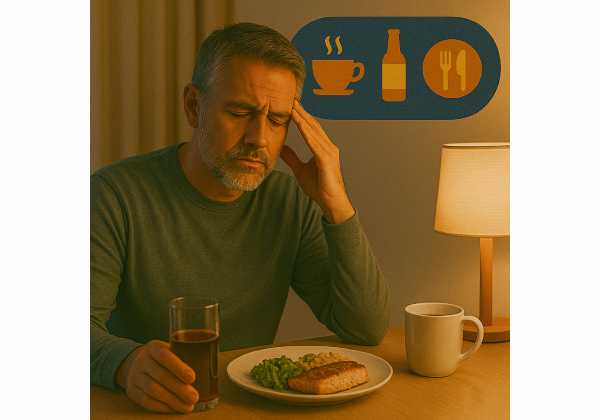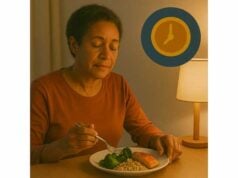
Good sleep is not only about bedrooms and bedtime rituals. It is also about when you consume stimulants, sedatives, and calories. Caffeine can linger for hours, alcohol reshapes sleep architecture, and late meals push digestion into the time your brain wants to recover. In midlife, when sleep becomes lighter and more fragmented, a few clear timing rules can restore deep, dependable rest. This guide translates the best evidence into practical cutoffs, menu choices, and travel tactics you can apply this week. You will learn how to adjust for personal sensitivity, how to handle social evenings, and how to test your own ideal windows without guesswork. For a broader foundation on recovery habits that support healthspan, explore our concise primer on sleep and stress for longevity.
Table of Contents
- Caffeine Half Life and Cutoff Times for Better Sleep
- Alcohol and Sleep Architecture: REM Suppression and Early Awakenings
- Late Meals and Digestion: What to Eat and When
- Personal Sensitivity: Genetics, Age, and Habitual Intake
- Travel and Shift Work: Adjusting Timing Rules on the Go
- Better Evening Choices: Decaf, Herbal Drinks, and Light Snacks
- Build Your Personal Cutoff Window: A Simple Testing Plan
Caffeine Half Life and Cutoff Times for Better Sleep
Caffeine is reliable at one thing: blocking adenosine receptors so you feel less sleepy. The catch is pharmacokinetics. In healthy adults, caffeine’s elimination half life commonly sits around five hours, but it ranges widely based on biology and context. That range matters: a late afternoon coffee can leave enough caffeine in circulation at bedtime to delay sleep and chip away at deep stages. Even when you fall asleep, residual caffeine can lighten sleep pressure and produce more awakenings.
A practical way to translate half life into behavior is to think in cutoff windows. If your target bedtime is 22:30, an eight-hour cutoff puts your last meaningful dose at 14:30. For many adults, that window protects sleep quality on work nights while still allowing a morning cup and an early afternoon top-off. People who metabolize caffeine more slowly—or who notice sensitive sleep—often do better with a 10–12 hour cutoff (e.g., 10:30–12:30 last dose for a 22:30 bedtime). The strongest evidence for real-world impact shows that even caffeine taken six hours before bed can reduce total sleep and increase wake time after sleep onset. That is why “no caffeine after mid-afternoon” is more than a slogan; it is a pragmatic line that respects biology.
Dosage and dose timing also interact. A single small espresso at noon behaves differently from a 16-oz cold brew at 16:00. High doses linger longer because clearance can slow at larger intakes. The same is true for certain medications and contexts: some antidepressants, oral contraceptives, and late pregnancy extend caffeine’s half life, while smoking can shorten it. If you use caffeine strategically for workouts or long drives, move it earlier, reduce the dose, or split into smaller amounts spread across your morning.
Two more levers improve sleep without giving up coffee:
- Front-load intake. Take most of your caffeine in the first half of the day. Many people thrive on a “90-minute rule”: wait at least 60–90 minutes after waking before your first dose to let natural cortisol and adenosine dynamics settle.
- Switch formats smartly. Espresso shots often contain less caffeine than large drip cups. Brew method, bean, and serving size matter. If you need an afternoon ritual, choose half-caf or decaf and keep volumes modest.
Finally, remember that perceived tolerance is not protection. You might feel “immune,” but sleep architecture still shifts in ways you cannot sense. The most convincing proof is personal data: when people extend their cutoff by two hours for two weeks, they usually see shorter sleep latency, fewer awakenings, and steadier morning energy.
Alcohol and Sleep Architecture: REM Suppression and Early Awakenings
Alcohol is a sedative, but sedation is not natural sleep. In the first sleep cycle, alcohol can shorten sleep latency and increase slow-wave activity. As the night progresses and alcohol is metabolized, the picture flips: REM sleep is suppressed early, wakefulness rises later, and sleep becomes fragmented. Many people recognize the pattern—fast knock-out, 03:00–04:00 awakenings, light dozing until the alarm.
The dose-response is clear in practice. Higher evening intake brings stronger early sedation and a more pronounced rebound in the second half of the night. Rebound shows up as more awakenings, vivid dreams, and an uptick in heart rate compared with alcohol-free nights. Consecutive drinking days can compound this effect. Even moderate amounts shift the rate at which REM accumulates across the night, leaving you with less REM overall and a less restorative profile.
Three practical rules keep social evenings compatible with sleep and next-day performance:
- Timing: Put your last drink at least three hours before lights out. If you go to bed at 23:00, aim to finish by 20:00. Earlier is better when the evening includes more than one drink.
- Spacing and dilution: Alternate with water and extend intervals between drinks. A slower rise in blood alcohol concentration reduces the sharp sedative front and the steep rebound later.
- Protect the second half: Keep the bedroom dark and cool, and plan a gentle re-entry if you wake (breathwork, audio story, no phone). A stable sleep setting can blunt fragmentation.
Content matters too. Sugary mixers can cause glucose swings and more awakenings. Heavy meals plus alcohol add reflux risk when you lie down. If snoring worsens with alcohol—common due to upper-airway relaxation—consider earlier last drink timing, lower doses, and side-sleeping. People with sleep apnea or loud snoring should be especially cautious; alcohol can worsen breathing stability.
If your focus is restoring REM and deep sleep balance, you will find complementary tactics in our practical overview of deep sleep and REM targets. The take-home message: alcohol shifts architecture predictably. You can still participate in social events while protecting sleep by moving drinks earlier, limiting total intake, and prioritizing hydration and room conditions.
Late Meals and Digestion: What to Eat and When
Your digestive system follows a daily rhythm. Eating late—especially large, high-fat, or spicy meals—raises body temperature and keeps the gut active during a period when your brain aims for stable, consolidated sleep. People feel this as longer sleep latency, more awakenings, and morning heaviness. Chrononutrition research adds a broader frame: shifting more calories earlier aligns better with circadian biology and often improves both sleep quality and metabolic markers.
A practical evening plan balances timing, size, and composition:
- Timing: Aim to finish dinner 3–4 hours before bed on most nights. When schedules are tight, a 2-hour buffer still helps. For very late workdays, split dinner: a small early plate and a light later plate rather than one heavy meal at 21:30.
- Size: Keep late meals modest. The later the hour, the smaller the portion. Think “comfortable, not stuffed.”
- Composition: Favor lean protein and cooked, low-fat sides in the evening. Minimize very spicy foods, very high fat dishes, and large raw salads late at night—they slow gastric emptying or trigger reflux. If you need a pre-sleep snack, choose 15–25 g protein with a small amount of complex carbohydrate (e.g., Greek yogurt with berries, a small glass of milk with a few whole-grain crackers, or cottage cheese with sliced fruit).
- Acid and reflux: If you are prone to heartburn, limit tomato sauces, citrus, chocolate, peppermint, and alcohol close to bedtime. Elevate the head of the bed by 10–15 cm if symptoms persist.
Hydration plays a role. Front-load fluids during the day and taper two hours before bed to reduce bathroom awakenings. If you exercise in the evening, refuel early, keep the post-workout meal light, and allow extra cooling time before lights out.
The goal is not dietary austerity; it is predictable digestion that supports sleep. Many readers find that simply moving the heaviest meal to midday and keeping supper lighter improves both sleep quality and morning energy within a week. If you want a structured plan that integrates meal timing with light and activity, skim our primer on chrononutrition basics.
Personal Sensitivity: Genetics, Age, and Habitual Intake
Not everyone responds to the same cup of coffee or glass of wine in the same way. Genetics and age-related physiology shape your sensitivity to stimulants, sedatives, and food timing.
- Caffeine metabolism: Variants in liver enzymes (notably CYP1A2) and adenosine receptors (ADORA2A) influence how quickly you clear caffeine and how strongly it affects sleep and anxiety. Slow metabolizers often need earlier cutoffs and smaller doses, while fast metabolizers can tolerate modest afternoon intake—though sleep architecture may still shift even without subjective jitteriness.
- Alcohol processing: Body water, enzyme activity, and sex differences in first-pass metabolism change breath alcohol curves. With age, the same number of drinks produces higher peak levels and more sleep fragmentation. Hormonal transitions (perimenopause, andropause) can also shift sensitivity: hot flashes, night sweats, and temperature dysregulation amplify alcohol’s disruptive effects.
- Habitual intake: Regular high caffeine intake builds tolerance to some alerting effects but does not eliminate sleep impact. Likewise, frequent evening drinking trains you to associate sedation with sleep onset but leaves sleep lighter and more wakeful later.
- Medications and conditions: Certain SSRIs, fluoroquinolones, and oral contraceptives can prolong caffeine half life. Sedating antihistamines combined with alcohol can intensify next-day grogginess. Reflux disease magnifies the sleep cost of late meals; sleep apnea magnifies alcohol’s breathing effects.
To translate these differences into action:
- Map your pattern: For two weeks, log bedtime, caffeine timing and dose, last drink time and dose, dinner timing and size, and morning alertness. Patterns emerge quickly.
- Adjust by sensitivity: If you are a light sleeper or notice strong effects, extend cutoffs: caffeine 10–12 hours, alcohol 4–5 hours, meals 3–4 hours before bed. If you sleep soundly even with moderate exposures, keep windows conservative during the workweek and loosen them slightly on weekends you can sleep in.
- Control what you can: You cannot change genes, but you can front-load stimulants, shift social drinks earlier, and design lighter evening menus. Small moves are often enough.
If your sleep timing also drifts later, pair these changes with light anchors and regular wake times. A straightforward refresher on biological timing lives in our overview of circadian basics.
Travel and Shift Work: Adjusting Timing Rules on the Go
Jet lag and shift schedules stress sleep because they unravel timing cues. Caffeine, alcohol, and meals can help or hurt depending on when you use them.
Before eastbound travel (you need to fall asleep earlier):
- Caffeine: Advance your caffeine window by 1–2 hours each of the two days before departure. Keep the last dose earlier than usual so your brain expects an earlier biological night.
- Alcohol: Avoid “plane nightcaps.” They increase dehydration, suppress REM early, and make cabin awakenings more likely. If you do drink, keep it to one and finish well before your planned in-flight sleep.
- Meals: Shift meals earlier the day before and on the travel day. A lighter dinner at the destination’s evening time helps your gut align with local night.
Before westbound travel (you need to stay up later):
- Caffeine: Use a later small dose (still outside your personal cutoff for the new bedtime) to stretch evening wakefulness after arrival. Avoid high doses that backfire with middle-of-the-night awakenings.
- Alcohol: Skip celebratory drinks right at local bedtime; you will fall asleep quickly but wake early. Save any drink for the late afternoon or with an early dinner.
- Meals: Anchor your first local lunch and local dinner on time even if you are not very hungry; small, balanced portions are enough to seed the new schedule.
On night shifts:
- Caffeine: Use front-loaded, small doses early in the shift; stop 6–8 hours before your planned daytime sleep. If you nap before the shift, avoid caffeine within three hours of the nap.
- Alcohol: Avoid using alcohol to “force” daytime sleep. It will degrade sleep quality and make the next night’s alertness worse.
- Meals: Keep a light main meal before the shift starts, a small snack around the biological night (typically 02:00–04:00), and a protein-forward breakfast before bed to prevent waking hungry. Dark, cool, quiet sleep environment plus a consistent pre-sleep routine are non-negotiable.
On planes: Hydrate, keep screens dim, and treat melatonin (if you use it) as a clock cue rather than a sedative—small doses timed for local bedtime can help, but avoid combining with alcohol. For a complete playbook that blends light exposure, melatonin, and meal timing across time zones and shifts, see our practical guide to jet lag strategies.
Better Evening Choices: Decaf, Herbal Drinks, and Light Snacks
Evenings do not have to feel restrictive. You can design pleasant substitutes that protect sleep and still feel like a treat.
If you want a warm drink ritual:
- Decaf coffee: Modern decaf contains a small amount of caffeine. If you are very sensitive, choose a smaller serving or switch to alternatives below.
- Herbal infusions: Chamomile, lemon balm, or rooibos offer warmth without stimulant load. Avoid large volumes late to limit bathroom trips.
- Milk-based options: A small glass of milk (or fortified alternative) provides protein and tryptophan. Keep added sugar low.
If you want a “social” substitute for alcohol:
- Bitters and soda or a citrus-herb spritz in a stemmed glass scratch the ritual itch without the sleep cost.
- Alcohol-free beers have improved; scan labels for very low alcohol by volume and modest sugar.
- Set a “finish time”: Even for non-alcoholic drinks, taper fluids in the last two hours before bed.
If you need a light snack:
- Pair 15–25 g of protein with a small complex carbohydrate: Greek yogurt and berries; cottage cheese and pineapple; a slice of whole-grain toast with turkey; edamame. Avoid greasy, spicy, or very large portions late.
- If reflux bothers you, keep your last bite at least three hours before bed and avoid peppermint, chocolate, and tomato sauces late.
If screens keep you up:
- Pair dim, warm light and low-arousal content with a hard stop 60–90 minutes before bed. If device brightness is low but you still feel wired, the culprit may be content, not light. Breathwork and gentle stretching help bridge to sleep. For screen and lighting tactics that reduce cognitive and circadian activation at night, skim our hands-on guide to screen hygiene.
Small rules that add up:
- Treat caffeine as a morning tool, alcohol as a social treat well before bed, and evening food as light and early. Most adults regain 15–30 minutes of sleep and fewer awakenings by sticking to those three lines for 10–14 days.
Build Your Personal Cutoff Window: A Simple Testing Plan
You do not need a lab to personalize timing rules. A two-week experiment reveals most of what you need to know.
Week 1 — Observe
- Keep your routine. Log each day’s last caffeine time and dose, last alcohol time and dose, dinner time and size, bedtime, sleep latency (estimate in minutes), night awakenings, and morning energy (1–5 scale). If you wear a device, also log sleep onset and wake after sleep onset (WASO) but treat them as supporting data, not gospel.
Week 2 — Intervene
- Caffeine: Set your cutoff to 8 hours before your target bedtime. If you usually sleep at 23:00, stop by 15:00. Keep doses smaller and earlier; avoid “rescue” shots late in the day.
- Alcohol: If you drink, finish at least 3 hours before lights out and cap intake at a modest amount. Alternate with water and keep mixers simple.
- Meals: Finish dinner 3–4 hours before bed. If you get hungry late, use a light protein-forward snack instead of a second dinner.
- Evening routine: Dim lights, reduce screen arousal, and add a five-minute wind-down (breathwork or quiet reading).
Compare
- Look for changes in sleep latency (aim for 10–25 minutes), fewer awakenings, and steadier morning energy. If sleep improved, you found a viable baseline.
Refine
- If you still wake too early or feel wired at night, extend the caffeine cutoff to 10–12 hours for another week. If you still have 03:00 awakenings after evenings out, move your last drink earlier or reduce the total. If reflux or heaviness wakes you, shift dinner earlier and lighter.
Lock it in
- Convert Week-2 wins into a weekday rule set (e.g., “Caffeine by 14:00, last drink by 19:30, dinner by 19:00”). Build weekend flex with intention (e.g., “One social night with earlier drinks and a later wake-up, never two in a row”).
- Re-run a mini-test after travel or schedule changes. Timing rules are portable; you only need to adjust the clock.
The endpoint is not perfection. It is a reliable baseline that keeps sleep restorative most nights while leaving room for real life. Once your windows are set, the rest of your toolkit—light exposure, movement, stress skills—works better because you are no longer fighting biology at bedtime.
References
- Caffeine Effects on Sleep Taken 0, 3, or 6 Hours before Going to Bed (2013)
- Pharmacokinetics of Caffeine: A Systematic Analysis of Human Data (2022) (Systematic Review)
- Altered sleep architecture following consecutive nights of presleep alcohol (2024)
- Effects of alcohol on sleep and nocturnal heart rate (2022)
- Association between meal timing and sleep quality (2024)
Disclaimer
This article is educational and is not a substitute for personalized medical advice, diagnosis, or treatment. Speak with a qualified clinician about caffeine, alcohol, and meal-timing choices if you have heart, liver, or gastrointestinal disease, take prescription medications that interact with caffeine or alcohol, are pregnant, or have sleep disorders such as insomnia, reflux, or sleep apnea. If sleep problems persist for more than a few weeks or impair daytime function, seek professional evaluation.
If this guide helped you, please consider sharing it on Facebook, X (formerly Twitter), or your preferred platform, and follow us for future updates. Your support helps us continue creating clear, practical resources on sleep and healthy aging.










